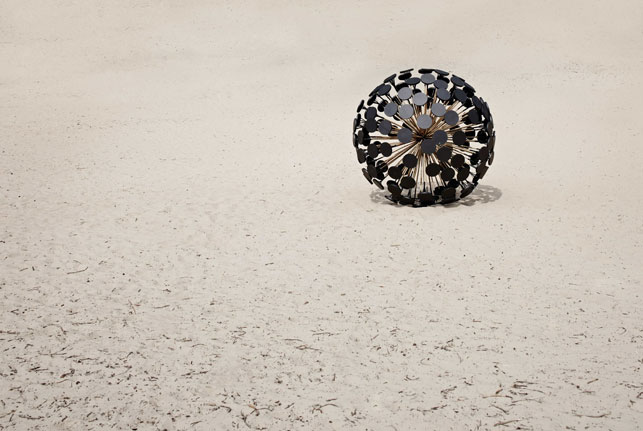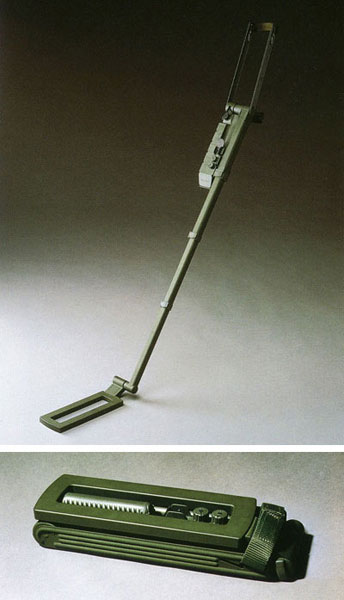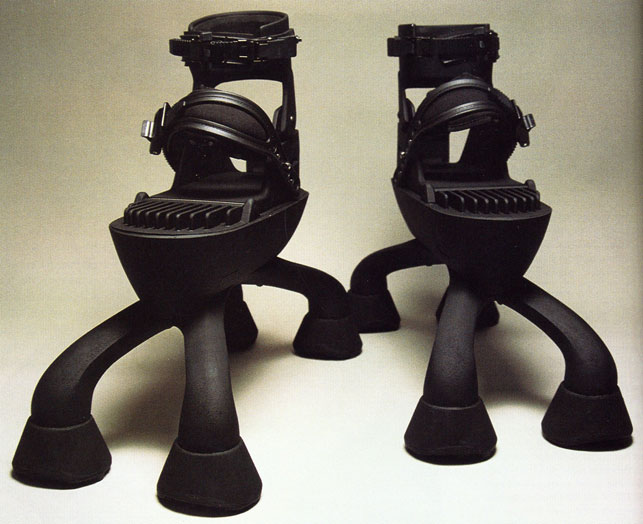
Massoud Hassani. Mine Kafon wind-powered deminer. 2011. Bamboo and biodegradable plastics, 87 x 87 x 87″ (221 x 221 x 221 cm). Gift of The Contemporary Arts Council of The Museum of Modern Art. Photo by Rene van der Hulst
Massoud Hassani’s wind-powered land minesweeper, the Mine Kafon, was inspired by the handmade toys from his childhood growing up in the desert north of Kabul, Afghanistan. As a boy, Hassani and his brother would fashion small paper toys to roll in the wind, racing them across the local fields. Years later, as a student working in the Netherlands, Hassani designed a much larger bamboo-legged, dinner-plate-footed, tumble-weedy, dandelion-like device that’s still light enough for the wind to take it across mine fields, but weighty enough to detonate the concealed mines in its rolling path.

Gerhard Heufler. MIMID Miniature Mine Detector (shown open and closed). 1996. Carbon fiber, 12 7/8″ X 4″ X 49 3/4″ (32.8 X 10.2 X 126.2 cm). Gift of Schiebel Elektronische Gerate GmbH. Photo by Tom Griesel
It’s hardly necessary to mention the evils of land mines; we’ve all read accounts and seen images of their appalling affects on innocent civilians across the globe—children especially. The statistics are staggering. According to the United Nations, in Afganistan alone there are 10 million unexploded land mines. So to create a life-saving device inspired by child’s play and send it riding on the wind is to fly in the face of a world out of balance; it is an act of poetic justice—or design justice.
The Mine Kafon is on view at MoMA in the exhibition Applied Design through January 20, and it returns to the galleries once again on February 14 as part of the exhibition A Collection of Ideas.
Two other innovative demining design objects that were originally exhibited in MoMA’s SAFE: Design Takes on Risk exhibition will also be on view in A Collection of Ideas: the MIMID Miniature Mine Detector and the Spider Boot Antipersonnel Mine Foot Protection System.
The MIMID: Miniature Mine Detector is a lightweight, portable, folding mine detecting device. It can be carried in a pack or a cargo-pants pocket and prepped on the spot in under than a minute. The Spider Boots, designed for deminers working in active minefields, feature a steel hull and honeycomb aluminum platform raised up on four wide-angled extension pods that deflect blast energy and shrapnel so as to minimize foot and lower-leg injuries.

Gad Shaanan Design, Inc. Spider Boot Anitpersonnel Mine Foot Protection System. 1998. Thermoplastics and proprietary composites, 20 1/2 X 8 5/8 X 13″ ( 52 X 22 X 33 cm). Photograph/Digital Image The Museum of Modern Art
The Mine Kafon is included in a section of A Collection of Ideas devoted to the theme of design and violence, linking the gallery installation to the MoMA online experimental curatorial project Design and Violence. The online project explores the relationship between design objects in our lives and the violence that occupies our world by looking through the lens of design objects that have an ambiguous relationship with violence. On the website, critical thinkers from fields as diverse as science, philosophy, literature, music, film, journalism, and politics consider selected design objects, positing arguments and ideas and sparking a conversation with all readers. The conversation is wide open and everyone’s input is welcome, so please be sure to visit the site and add your own.

